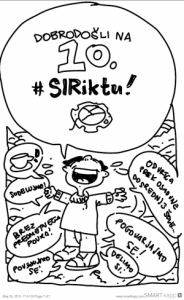Matjaž Ovsenek, Osnovna šola Simona Jenka Smlednik, Smlednik
Mateja Žepič, Gimnazija Kranj, Kranj
Slovene pupils and students increasingly use smart phones for peer-to-peer communication. The authors of this article have decided to acknowledge this fact and extend the use of smart phones also to school education. In order to make this use fruitful for learning purposes, youth need to see explicit goals in everyday life and spare time. The purpose of this exercise was to connect peer groups – elementary school pupils and secondary school students from different living environments – city and town – and increase knowledge transfer between the groups. The goal was to make meaningful use of smart phones in education, thus enrich the learning process and motivate the learners. The learners were encouraged to use various skills, connected to use of smart phones (applications, team work, and use of imagination in the field work). The learners were divided into small groups and directed to an orientation walk. They were following the path (city or village) by use of interactive application maps Scribble maps on their smart phones/tablets. Certain tasks were assigned to them during the walk, linked to the curriculum of ICT/computing and physical education. The tasks were delivered in different forms (text, picture, QR code). Contextually, the learners were required to produce: photographs, videos, sounds and anaglyphs (3D pictures), heart beat measurements (before, between and after activity) and measurements of the orientation path itself. The tasks required pre-loading and testing of different applications. To solve individual assignments, the learners were encouraged to use and link different skills and to find the optimal solutions to the faced challenges. The solution had to demonstrate the path, the number of steps (by using pedometer) and the altitude (use of tracker application).
